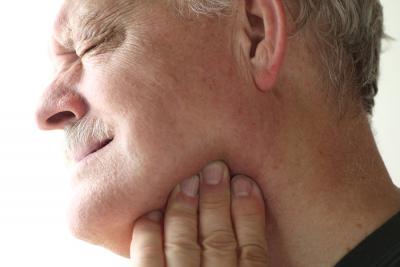Greetings
In our November newsletter we are exploring Jaw Pain.
| Many people suffer from TMD or temporo-mandibular joint disorder. TMD refers to pain in the jaw joint and surrounding tissues. This joint is made up of muscles, tendons, and bones, and injury to any of these structures can cause pain in the jaw. Symptoms of TMD include: sore jaw muscles, ear pain, headaches, pain in the cheeks or temples, ringing in the ears, jaw clicking or popping, difficulty opening one’s mouth, and/or locking of the jaw. |
 |
Causes of TMD:
There are a number of factors that can cause jaw disorders.
TMD can be caused by muscle tension, injuries, and wear due to aging.
Tension in the muscles that control the jaw, and of the neck are often the cause of symptoms. Many factors contribute to muscle tension such as poor posture, postural strain from work, stress, tooth grinding or clenching, gum chewing, chewing only on one side of the mouth, or tooth misalignment.
A severe injury such as a blow to the jaw could fracture the jaw or damage the disc, muscles, and ligaments. Whiplash injuries can cause damage to the TM joint, and often symptoms don't show up until a year later.
Wear and tear of the joint due to aging can cause stiffness, pain, and muscle tension. Arthritis of the jaw and joint stiffness can also result from injury.
Home Remedies:
If TMJ dysfunction is diagnosed early on, the following home-remedies can help improve your symptoms:
- Take excessive pressure off of your jaw muscles and joints by eating soft foods and avoid chewing gum.
- Try to avoid clenching, tensing, or grinding your teeth. Clenching is one of the most common causes of TMJ pain.
- Relax your muscles by applying moist heat to your jaw twice a day for at least half an hour, or try gently massaging the muscles in your cheeks and temples.
- If your TMJ pain is the result of an injury, ice packs can be applied to the area to reduce swelling.
The Physiotherapist's Role:
The physiotherapists at River Heights Physiotherapy have advanced training in the diagnosis and treatment of jaw disorders.
Our physiotherapists are specially trained to assess, diagnose, and treat TMD's. We often work in cooperation with your dentist to ensure optimal results. We take a detailed medical, dental, and lifestyle history to get to the root cause of your problem.
We do a detailed bio-mechanical examination of your jaw and neck. We assess all of the muscles, joints, and ligaments, as well as the TM joint discs. We can identify muscle tension, shortening, and weakness. Movement quality and control are identified. Ligament laxity and joint stiffness are tested. We feel for popping or grating sounds and test to make sure the TM joint disc is moving properly. We assess the facial and neck nerves. We also examine your bite, and will refer you to a dentist if indicated.
Treatment often includes hands on therapy to restore joint movement, and relax muscles in the face and neck. Acupuncture can help relax muscles and reduce inflammation. Ultrasound helps with inflammation and healing. Heat or ice are often used. Electrical stimulation can help with pain and muscle tension. Specific exercises will be provided to restore movement, reduce joint sounds, improve strength, and relax muscles. We educate you on how to modify your lifestyle factors that may be contributing to your condition.
If you think you are suffering from TMD pain you should contact the physiotherapists at River Heights Physiotherapy. One of our physiotherapists would be happy to assess your current jaw pain and create a program tailored specifically to your needs and goals. Call River Heights Physiotherapy at 204-987-9222 to make an appointment or to ask any questions you may have.
Don't suffer with TMD. Physiotherapy can help!
References
- Rollman A, Visscher CM, Gorter RC, Naeije M. Care seeking for orofacial pain. J of Orofac Pain. 2012; 26(3):206-14.
- Tuz HH, Onder EM, Kisnisci RS. Prevalence of otologic complaints in patients with temporomandibular disorder. Am J Orthod Dentofacial Orthop. 2003; 123(6):620-23.
- Schiffman E, Ohrbach R, List T, et al. Diagnostic criteria for headache attributed to temporomandibular disorders. Cephalagia. 2012; 32(9):683-92.
- Kluemper GT, Hiser DG, Rayens MK, Jay MJ. Efficacy of a wax containing benzocaine in the relief of oral mucosal pain caused by orthodontic appliances. Am J Orthod Dentofacial Orthop. 2002; 122(4):395-65.
- Hersh EV, Stoopler ET, Secreto SA, Derossi SS. A study of benzocaine gel dosing for toothache. J Clin Dent. 2005; 16(4):103-8.
- Poveda-Roda R, Bagan JV, Sanchis JM, Carbonell E. Temporomandibular disorders: A case-control study. Med Oral Patol Oral Cir Bucal. 2012 (in press.)